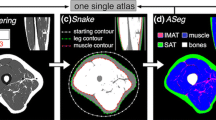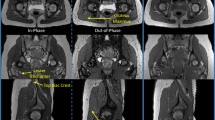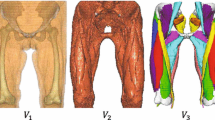Abstract
Objective
To quantify individual muscle volume in rat leg MR images using a fully automatic multi-atlas-based segmentation method.
Materials and methods
We optimized a multi-atlas-based segmentation method to take into account the voxel anisotropy of numbers of MRI acquisition protocols. We mainly tested an image upsampling process along Z and a constraint on the nonlinear deformation in the XY plane. We also evaluated a weighted vote procedure and an original implementation of an artificial atlas addition. Using this approach, we measured gastrocnemius and plantaris muscle volumes and compared the results with manual segmentation. The method reliability for volume quantification was evaluated using the relative overlap index.
Results
The most accurate segmentation was obtained using a nonlinear registration constrained in the XY plane by zeroing the Z component of the displacement and a weighted vote procedure for both muscles regardless of the number of atlases. The performance of the automatic segmentation and the corresponding volume quantification outperformed the interoperator variability using a minimum of three original atlases.
Conclusion
We demonstrated the reliability of a multi-atlas segmentation approach for the automatic segmentation and volume quantification of individual muscles in rat leg and found that constraining the registration in plane significantly improved the results.





Similar content being viewed by others
Abbreviations
- 3D:
-
Standard 3D nonlinear registration process
- SBS:
-
Slice-by-slice nonlinear registration process
- 2Dc:
-
2D constrained nonlinear registration process
- R-:
-
Rescaled along Z
- RO:
-
Relative overlap index
- CV:
-
Coefficient of variation
- ICC:
-
Intraclass coefficient
- mv:
-
Majority vote procedure
- wv:
-
Weighted vote procedure
- z0:
-
No slice translation
- z1:
-
1 slice translation
- z2:
-
2 slice translation
- DSC:
-
Dice similarity coefficient
References
Park SW, Goodpaster BH, Strotmeyer ES, de Rekeneire N, Harris TB, Schwartz AV, Tylavsky FA, Newman AB (2006) Decreased muscle strength and quality in older adults with type 2 diabetes: the health, aging, and body composition study. Diabetes 55:1813–1818
Barbat-Artigas S, Rolland Y, Zamboni M, Aubertin-Leheudre M (2012) How to assess functional status: a new muscle quality index. J Nutr Health Aging 16:67–77
Metter EJ, Talbot LA, Schrager M, Conwit R (2002) Skeletal muscle strength as a predictor of all-cause mortality in healthy men. J Gerontol A Biol Sci Med Sci 57:B359–B365
Tonson A, Ratel S, Le Fur Y, Cozzone P, Bendahan D (2008) Effect of maturation on the relationship between muscle size and force production. Med Sci Sports Exerc 40:918–925
Morse CI, Tolfrey K, Thom JM, Vassilopoulos V, Maganaris CN, Narici MV (2008) Gastrocnemius muscle specific force in boys and men. J Appl Physiol 104:469–474
Jubrias SA, Odderson IR, Esselman PC, Conley KE (1997) Decline in isokinetic force with age: muscle cross-sectional area and specific force. Pflüg Arch Eur J Physiol 434:246–253
Hasson CJ, Kent-Braun JA, Caldwell GE (2011) Contractile and non-contractile tissue volume and distribution in ankle muscles of young and older adults. J Biomech 44:2299–2306
Hug F, Marqueste T, Le Fur Y, Cozzone PJ, Grélot L, Bendahan D (2006) Selective training-induced thigh muscles hypertrophy in professional road cyclists. Eur J Appl Physiol 97:591–597
Kalyani RR, Corriere M, Ferrucci L (2014) Age-related and disease-related muscle loss: the effect of diabetes, obesity, and other diseases. Lancet Diabetes Endocrinol 2:819–829
Brown M, Hasser EM (1996) Complexity of age-related change in skeletal muscle. J Gerontol A Biol Sci Med Sci 51:B117–B123
Frontera WR, Reid KF, Phillips EM, Krivickas LS, Hughes VA, Roubenoff R, Fielding RA (2008) Muscle fiber size and function in elderly humans: a longitudinal study. J Appl Physiol 105:637–642
Kesper K, Kornblum C, Reimann J, Lutterbey G, Schröder R, Wattjes MP (2009) Pattern of skeletal muscle involvement in primary dysferlinopathies: a whole-body 3.0-T magnetic resonance imaging study. Acta Neurol Scand 120:111–118
Akagi R, Takai Y, Ohta M, Kanehisa H, Kawakami Y, Fukunaga T (2009) Muscle volume compared to cross-sectional area is more appropriate for evaluating muscle strength in young and elderly individuals. Age Ageing 38:564–569
Mattei JP, Fur YL, Cuge N, Guis S, Cozzone PJ, Bendahan D (2006) Segmentation of fascias, fat and muscle from magnetic resonance images in humans: the DISPIMAG software. Magn Reson Mater Phy 19:275–279
Positano V, Christiansen T, Santarelli MF, Ringgaard S, Landini L, Gastaldelli A (2009) Accurate segmentation of subcutaneous and intermuscular adipose tissue from MR images of the thigh. J Magn Reson Imaging 29:677–684
Klein CS, Rice CL, Marsh GD (2001) Normalized force, activation, and coactivation in the arm muscles of young and old men. J Appl Physiol 91:1341–1349
Smeulders MJC, van den Berg S, Oudeman J, Nederveen AJ, Kreulen M, Maas M (2010) Reliability of in vivo determination of forearm muscle volume using 3.0 T magnetic resonance imaging. J Magn Reson Imaging 31:1252–1255
Nordez A, Jolivet E, Südhoff I, Bonneau D, de Guise JA, Skalli W (2009) Comparison of methods to assess quadriceps muscle volume using magnetic resonance imaging. J Magn Reson Imaging 30:1116–1123
Gilles B, Magnenat-Thalmann N (2010) Musculoskeletal MRI segmentation using multi-resolution simplex meshes with medial representations. Med Image Anal 14:291–302
Wang C, Teboul O, Michel F, Essafi S, Paragios N (2010) 3D knowledge-based segmentation using pose-invariant higher-order graphs. Med Image Comput Comput-Assist Interv 13:189–196
Andrews S, Hamarneh G, Yazdanpanah A, HajGhanbari B, Reid WD (2011) Probabilistic multi-shape segmentation of knee extensor and flexor muscles. Med Image Comput Comput-Assist Interv 14:651–658
Sdika M (2010) Combining atlas based segmentation and intensity classification with nearest neighbor transform and accuracy weighted vote. Med Image Anal 14:219–226
Rohlfing T, Brandt R, Menzel R, Maurer CR (2004) Evaluation of atlas selection strategies for atlas-based image segmentation with application to confocal microscopy images of bee brains. NeuroImage 21:1428–1442
Isgum I, Staring M, Rutten A, Prokop M, Viergever MA, van Ginneken B (2009) Multi-atlas-based segmentation with local decision fusion–application to cardiac and aortic segmentation in CT scans. IEEE Trans Med Imaging 28:1000–1010
Klein S, van der Heide UA, Lips IM, van Vulpen M, Staring M, Pluim JPW (2008) Automatic segmentation of the prostate in 3D MR images by atlas matching using localized mutual information. Med Phys 35:1407–1417
Karlsson A, Rosander J, Romu T, Tallberg J, Grönqvist A, Borga M, Dahlqvist Leinhard O (2015) Automatic and quantitative assessment of regional muscle volume by multi-atlas segmentation using whole-body water-fat MRI. J Magn Reson Imaging 41:1558–1569
Thomas MS, Newman D, Leinhard OD, Kasmai B, Greenwood R, Malcolm PN, Karlsson A, Rosander J, Borga M, Toms AP (2014) Test-retest reliability of automated whole body and compartmental muscle volume measurements on a wide bore 3T MR system. Eur Radiol 24:2279–2291
Giannesini B, Izquierdo M, Le Fur Y, Cozzone PJ, Fingerle J, Himber J, Künnecke B, Von Kienlin M, Bendahan D (2005) New experimental setup for studying strictly noninvasively skeletal muscle function in rat using 1H-magnetic resonance (MR) imaging and 31P-MR spectroscopy. Magn Reson Med 54:1058–1064
Sled JG, Zijdenbos AP, Evans AC (1998) A nonparametric method for automatic correction of intensity nonuniformity in MRI data. IEEE Trans Med Imaging 17:87–97
Zhang Y, Brady M, Smith S (2001) Segmentation of brain MR images through a hidden Markov random field model and the expectation-maximization algorithm. IEEE Trans Med Imaging 20:45–57
Jenkinson M, Smith S (2001) A global optimisation method for robust affine registration of brain images. Med Image Anal 5:143–156
Sdika M (2008) A fast nonrigid image registration with constraints on the Jacobian using large scale constrained optimization. IEEE Trans Med Imaging 27:271–281
Artaechevarria X, Munoz-Barrutia A, Ortiz-de-Solorzano C (2009) Combination strategies in multi-atlas image segmentation: application to brain MR data. IEEE Trans Med Imaging 28:1266–1277
Elliott MA, Walter GA, Gulish H, Sadi AS, Lawson DD, Jaffe W, Insko EK, Leigh JS, Vandenborne K (1997) Volumetric measurement of human calf muscle from magnetic resonance imaging. Magn Reson Mater Phy 5:93–98
Cabezas M, Oliver A, Lladó X, Freixenet J, Cuadra MB (2011) A review of atlas-based segmentation for magnetic resonance brain images. Comput Methods Programs Biomed 104:e158–e177
Gubern-Mérida A, Kallenberg M, Martí R, Karssemeijer N (2012) Segmentation of the pectoral muscle in breast MRI using atlas-based approaches. Med Image Comput Comput-Assist Interv 15:371–378
Morse CI, Degens H, Jones DA (2007) The validity of estimating quadriceps volume from single MRI cross-sections in young men. Eur J Appl Physiol 100:267–274
Tracy BL, Ivey FM, Jeffrey Metter E, Fleg JL, Siegel EL, Hurley BF (2003) A more efficient magnetic resonance imaging-based strategy for measuring quadriceps muscle volume. Med Sci Sports Exerc 35:425–433
Kent-Braun JA, Ng AV, Young K (2000) Skeletal muscle contractile and noncontractile components in young and older women and men. J Appl Physiol 88:662–668
Author’s contribution
Michael Sdika: project development, data management and data analysis; Anne Tonson: project development, data collection and data analysis; Yann Le Fur: data collection; Patrick J. Cozzone: data analysis; David Bendahan: data analysis.
Author information
Authors and Affiliations
Corresponding author
Ethics declarations
Conflict of interest
The authors declare that they have no conflict of interest.
Ethical standards
All procedures involving animals were performed according to the guidelines of the National Research Council Guide for the care and use of laboratory animals and the French law on the Protection of Animals.
Additional information
Michael Sdika and Anne Tonson have contributed equally to this work.
Rights and permissions
About this article
Cite this article
Sdika, M., Tonson, A., Le Fur, Y. et al. Multi-atlas-based fully automatic segmentation of individual muscles in rat leg. Magn Reson Mater Phy 29, 223–235 (2016). https://doi.org/10.1007/s10334-015-0511-6
Received:
Revised:
Accepted:
Published:
Issue Date:
DOI: https://doi.org/10.1007/s10334-015-0511-6




